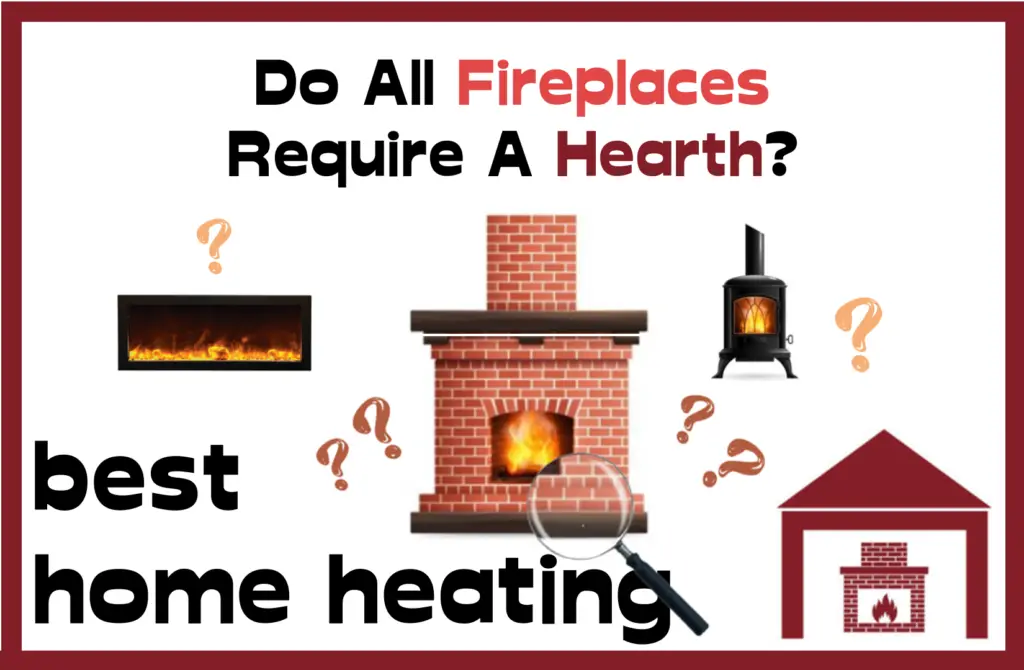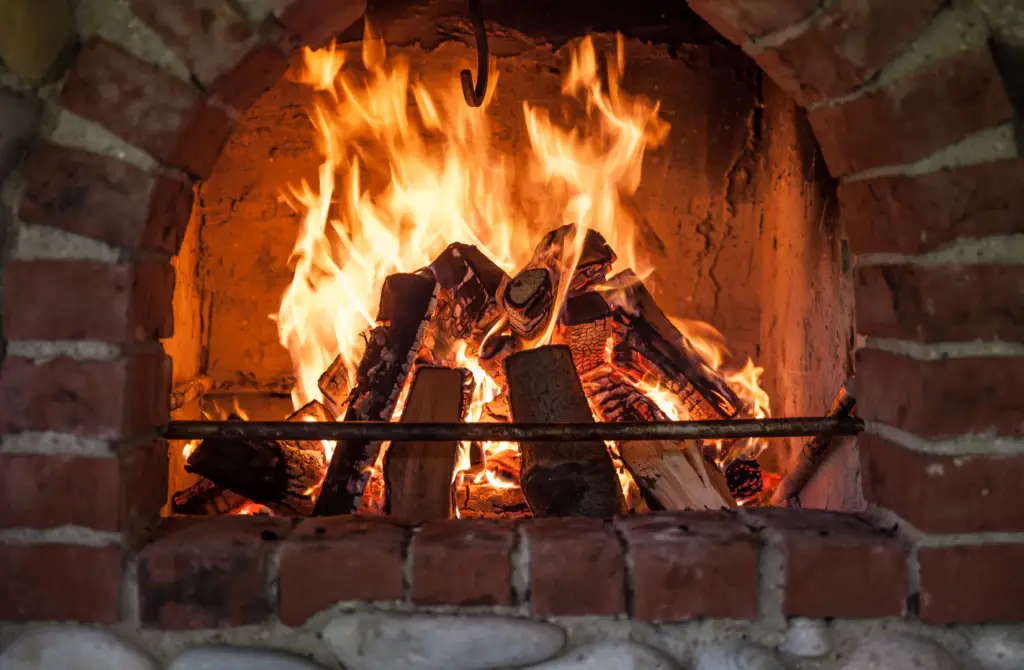The hearth, encompassing the floor, ledge, and surrounding wall of the fireplace, serves a functional role beyond aesthetics, ensuring safety and fire prevention in the designated area.
They extend into the floor space, preventing burning embers or logs from dropping onto the floor and potentially burning your carpets and floor coverings. A hearth is required for most wood-burning fireplaces, some gas fireplaces, and few to no electric fireplaces.
Curious to know more about whether all fireplaces necessitate a hearth? Read on to find out more!

What does a hearth do?
The primary function of a fireplace hearth is to protect the floor in front and to the side of your fireplace from heat and combusting materials, keeping your home safe. In summary, the hearth serves as a barrier between the fire’s flames, embers, and heat and your home. The enlarged portion of the hearth that protrudes from the fireplace is utilized to keep ash, soot, and embers from falling on your floor. Furthermore, it is to also keep family members safe from the open flame.
A hearth is also a vital feature and secure spot for storing critical fireplace accessories and tools as well as following construction and fire requirements and providing an interior design touch to your living space.
Which Fireplace Types Require a Hearth?
Burning-Wood Fireplaces
The most popular fireplaces with hearths are those that burn wood since they produce the most heat (up to 2000 F). Hearths are nearly always necessary for wood-burning fireplaces. This is because wood is a solid fuel with a higher temperature and combustion area (along with cracking and popping).
Gas fireplace
A hearth is necessary for a natural vent gas fireplace, whereas other criteria apply to direct vent and ventless fireplaces. Due to its open front design, hearths are advised for use with natural vent fireplaces. This allows air from the surrounding space to flow via the chimney,
Depending on the manufacturer’s specifications, direct vent and ventless fireplaces typically feature a glass front restricting the home’s airflow from entering or exiting the firebox, making them less likely to require a hearth.
In general, depending on the type and the manufacturing requirements, gas fireplace requirements for a hearth vary. Consult your fireplace’s instruction manual to learn more about the sort of fireplace you have, as well as the manufacturer’s requirements and suggestions, before deciding if your gas fireplace needs a hearth.
Electric fireplaces
Hearths are not necessary for electric fireplaces since they use electricity as their fuel source instead of a genuine flame. Its heat is created by a heater system, making the fireplace colder to the touch, while its flames are produced by lights and moving mirrors.
The best material for the hearth
A hearth must be created with non-combustible materials in order to serve its purpose. Granite, slate, marble, brick, soapstone, limestone, and concrete are the most often used materials for hearths. Each material has advantages and disadvantages to consider when determining how to build or purchase a hearth.
Before purchasing the material, examine its fire resistance, heat threshold, durability, attractiveness, pricing. You should also examine if it splits or chips as a result of temperature fluctuations. Brick, for example, is the most common material used for all fireplaces due to its excellent heat resistance, ease of installation, and low cost, but it may not suit everyone’s style.
Granite is another wonderful alternative if you want a range of colours, textures, or patterns to choose from. But Granite will expand and contract depending on heat and the number of slab layers you place. The general rule of thumb with granite is to prevent excessive heat from solid fuels like wood owing to the possibility of chipping and cracking if just one layer has been applied.
Building regulations regarding hearth in fireplaces

What should be the size?
To make your home safe in the event of a fire, you should abide by the county-specific recommendations for appropriate fireplace sizes. In the UK, Part J of The Building Regulations contains information on necessary hearth sizes.
According to UK Building Regulations, a hearth must extend at least 300mm into the room for an open appliance and at least 150mm to the side of a firebed. The 300mm can be decreased to 225mm for appliances that are closed. The hearth of an open fireplace must extend into the room by at least 500mm.
According to the international association of certified home inspectors, a hearth should extend at least 16 inches (406mm) into the room from the opening and by at least 8 inches (203mm) away from the sides for fireplaces with openings that are 6 square feet (0.56 square metres) or less.
The heath should reach at least 20 inches (508mm) from the fireplace and at least 12 inches (305mm) to the sides of fireplaces with openings larger than 6 square feet.
What should be the thickness?
The international association of certified home inspectors advises that a hearth’s thickness be at least 4 inches for any size fireplace opening (102mm).
When surface temperatures on the hearth do not reach 100 degrees Celsius, hearths must be at least 12 mm thick. This is according to UK Building Regulations. If there is at least a 50mm gap beneath the hearth, it must be at least 125mm thick for temperatures exceeding 100 C. Additionally, at least 250mm thick if it is situated on a flammable floor.

Can I have a fireplace without a hearth?
Well, it depends. If you have a wood burning or gas fireplace, it is strongly advised to have a hearth. You can skip to having a hearth if you have a solid stone floor without any carpet. However, this is still not recommended. With an electric fireplace, you can certainly skip the hearth.
Do modern fireplaces require a hearth?
Building codes do not consider a modern gas fire, which does not need a chimney, to be a true fireplace. Like a refrigerator or a dishwasher, a gas fire is regarded as an appliance. Therefore, unless the manufacturer’s installation instructions specify otherwise, if your home is equipped with a contemporary gas fire, you may do without the hearth. You can instead build a wood, composite, or laminate floor that extends all the way up to the base.
Does a wood burning stove require a hearth?
Although they may be securely put in a variety of different areas throughout a house, wood burning stoves are frequently built within open fireplaces. Every wood stove will need a hearth that is big enough. A hearth serves as a barrier between a stove and a home’s floor. The body of a wood stove is made to grow extremely hot. Your local and federal building codes will determine the needed size of a hearth. It must be set back from a stove a particular amount of space.
Conclusions
The hearth is the area of your fireplace’s floor or ledge that faces the surrounding wall. They extend onto the floor area. This prevents falling embers or logs from burning your carpets and floor coverings if they do. Most wood-burning fireplaces, some gas fireplaces, and very few electric fireplaces need a hearth. For an open appliance, a hearth must reach at least 300mm into the room. For a firebed, at least 150mm. A hearth must extend at least 150mm to the side of a firebed. Additionally, 300mm into the room for an open appliance.
